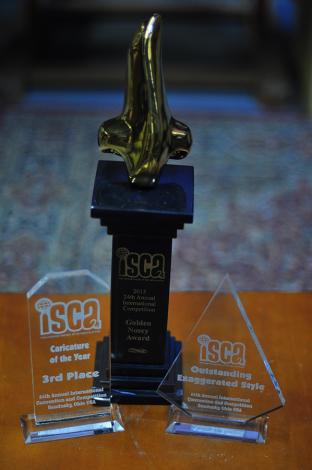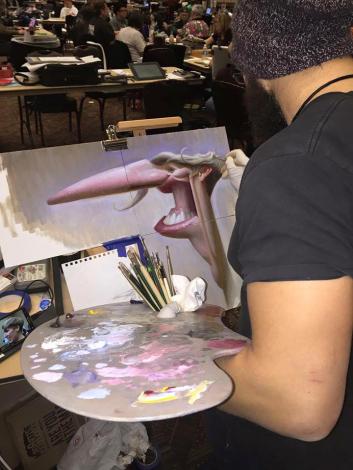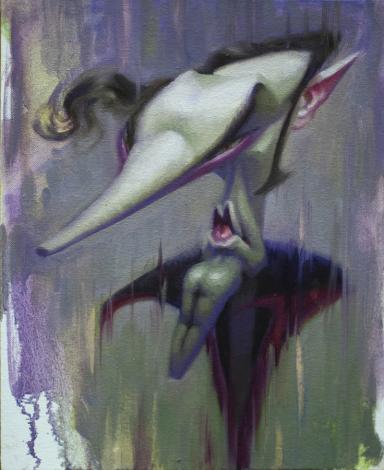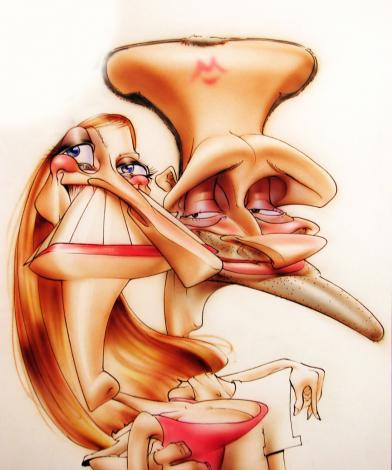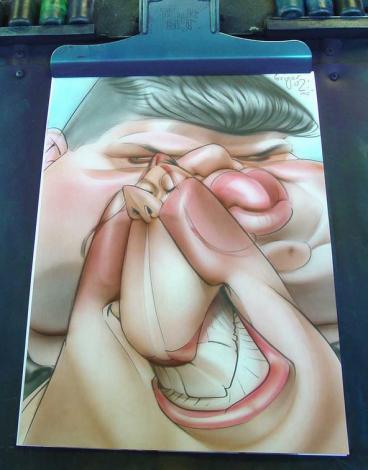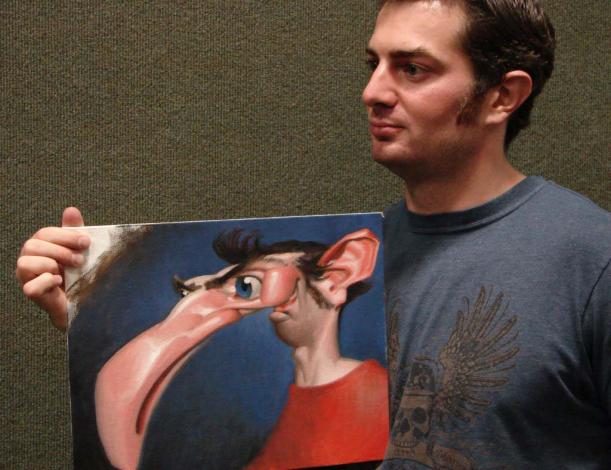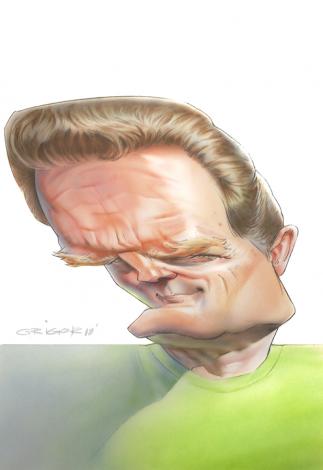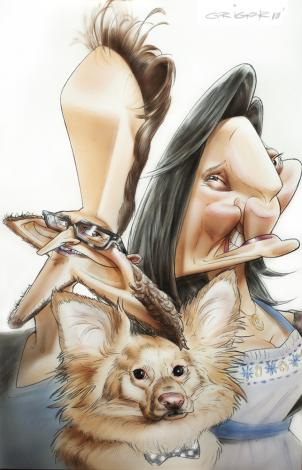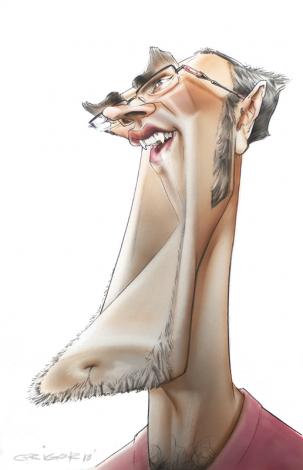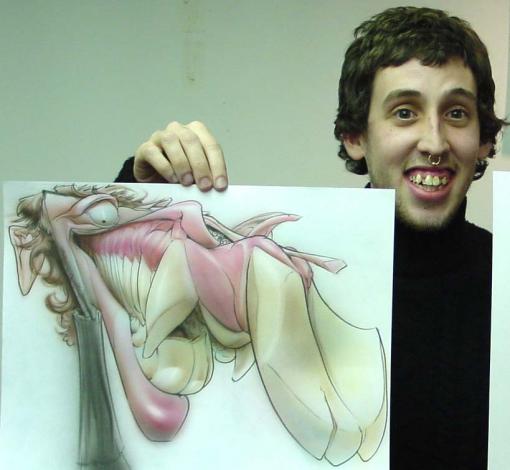Posted on Tuesday, June 23, 2020
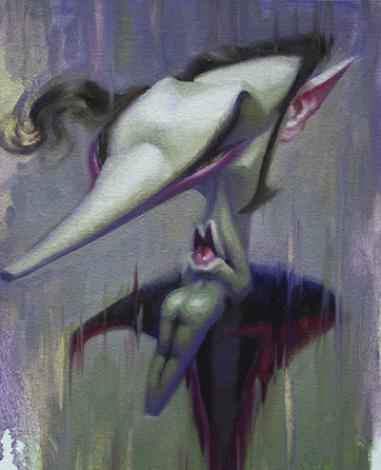
I'm excited to present my third interview with Grigor Eftimov. In this one, we go deep into the topics of Grigor's background with caricature drawing, his process, and how he learned to create award-winning caricature art. We also explore the relationship between caricature drawing and realism and realistic portrait drawing. Even if you don't intend to ever do any caricature or cartoon drawing, I hope you enjoy this journey into some of the core concepts of realistic art.
(Read my first and second interviews with Grigor to learn more about his background, art, and teaching.)
Ben: Tell me how many years have you been doing caricatures and some of the awards that you’ve received.
Grigor: Well, currently I am a retired caricature artist but I still do it for fun. When I did it seriously I did it for about a good five years before doing storyboards. It's been almost 20 years since I went to my first caricature convention of the International Society of Caricature Artists in 2001. I can't remember all the awards but to name a few: 1st place Best Exaggeration, 1st place black & white, and 1st place best profile, as well as a bunch of minor categories. Overall I think 8 awards and 15th place. A couple years after working at the theme park I went to the convention again in 2006 and won second place overall, the Silver Nosey. That year I also won 1st place Best Exaggeration, 1st place Caricature of the Year, 5th place Caricature of the Year (2 times in the same category) and 3rd place best portfolio. In 2016 I went back again and won 1st place overall, the Gold Nosey, as well as 1st place Outstanding Exaggerated style and 3rd place Caricature of the Year.
Ben: How did you learn to draw caricatures?
Grigor: My first attempts were in my fundamentals class at the American Academy of Art. The teacher really wanted caricatures of everybody in the class. There was a guy in my class, Lalo Sylvia, and I watched him. At the time my caricatures were basically just weird cartoon portraits.
Where I really learned to draw caricatures was a job at Six Flags Great America working for a guy named Gary Fasen. He ran the caricature business at Six Flags and would visit the Academy to do recruiting. The summer after my first year at the Academy I was living with my father, and my father made me work with him for the summer. The following summer, I really pushed on wanting to work for Gary, so my father let me. So I contacted Gary and arranged to meet him, in person, at the park for an interview.
"....if I can’t draw, right now, on the spot for you...then I don’t deserve this job."
I drove out to the park and met him. When I got there, he asked “where’s your portfolio?” I replied “I didn’t bring one, I don’t have one for caricatures.” So he replied “how can you come to an interview for a drawing job with no portfolio!!??” So I replied “Look man, if I can’t draw, right now, on the spot for you...then I don’t deserve this job.” So he said “ok…” and gave me a picture of Sylvester Stallone to draw. I drew it. And after a while Gary came back and saw what I drew. I asked “So...do I get the job?” He replied “yeah...but the mouth sucks…” and showed me how to correct it. And that’s how I got my first caricature job with no portfolio.
So I started working for Gary. The way he started new artists was by telling customers that the artist was in training. So that’s how I began. I would tell people that I was in training, and I would draw them. If they liked my drawing, they could buy it. If not, they did not have to pay for it. That’s how we all started, just thrown into the fire.
Most artists are very reclusive and never put on the spot like that. We had to deal with the public every day and draw under pressure. If you made it halfway through the summer, you would be fine for the rest of the summer. A lot of artists could not deal with the pressure. It was the summer, so it was hot and crowded, you’re sweating, and people are watching and waiting. It definitely toughened you up as an artist, and after doing that I felt there was no art task or pressure I could not handle. Everything after that was a walk in the park.
Ben: Stepping back for a second, and focusing on Gary and his business. You came with some ability to draw caricatures already, as you described. Not all his artists would have had that, in the same way. Did he provide any training?
Grigor: Yes. He showed us a failsafe procedure that we all learned and clung to. On top of all the pressure of the people and the summer, we also did these caricatures in airbrush. We would start out the drawing with graphite pencil, then finish it with airbrush. So we had to have a procedure to fall back on. It was Gary’s invention. He had been doing this for 20 years, so knew the process inside out, and how to get artists going. Everyone had to rely on it, in the beginning, and when they started, everyone’s caricatures always started off with the same look, that was a kind of weird mix of what the subject looked like, and Gary’s style. The caricatures were kind of generic, and not offensive, but they made people happy, and the procedure is what got us all through being able to do these drawings and airbrush them in the beginning.
Ben: Can you describe the procedure?
Grigor: Yes. So when the customer sits down in front of you, you first look at their general shape. Without drawing, you first observe and decide for yourself what the head-shape is. Is it round, or square, or really rectangular? Then you start with the eyes, and the left eyelid. You place the left eyelid, based on the head shape, then place the right eyelid. Then you compare to the head-shape and decide if the eyes should be closer together, or further apart. Then you place the left-nostril, then the right-nostril. You place those relative to the eyes and your overall impression.
Then, based on those you place the mouth, then the chin. So it goes eyes, nose, mouth, chin. Then when you’ve placed these, you go to the sides of the head. You look at the temple and compare to the eyes, then the cheeks in relation to the mouth. If the subject is smiling, you might make the cheeks bigger and pull the chin up. Then you go back up and look at the hair-line, relative to the eyes, and draw the inside-line of the hair, then the outer lines and layers of the hair. So this was basically going from side to side and down the face, then back up. By this time you should have most of the features placed, so you could go back in and define the details a bit more.
Ben: Who are some of your favorite caricature artists?
Grigor: Right now, Jan Op De Beeck, in Belgium. And he's been around for quite a while he does amazing live caricature. He's freaking awesome. Another one in terms of editorial work, I like my friend Jason Seiler. He's the best. if not the best at editorial caricatures. There's another guy named Steve Brodner. He does some really crazy abstract political caricature. Then there is Sebasitan Kruger who is super well known, and everyone looks up to. If I go way back, Gustave Dore did caricatures.
Ben: What in your mind makes for a really good, or even great, caricature?
Grigor: Well there are many good caricature artists out there. I have to answer that from my own perspective of what I think is good. I’ve always had a hard time doing caricatures of celebrities. The reason is because if an actual celebrity sat down in front of me, I would not draw them in the typical way people think of that celebrity.
"To really break that mold.. ...you have to not look at that stuff, because it will influence how you see a subject..."
Most of the time, when people think of, or picture celebrities, they think of them in some sort of role, and acting in that role. But Sylvester Stallone is not Rocky. He is not actually Rambo. But many caricature artists, when they draw Stallone they draw him as Rocky or Rambo, and over time, the caricatures become exaggerations of exaggerations of exaggerations. To really break that mold, as an artist, you have to not look at that stuff, because it will influence how you see a subject like Stallone. As an artist, you have to break that mold and really be very sincere in your take on the subject, and do a take on it that you’ve never seen before. You have to act like you’ve never seen this person before.
So when I see a caricature or drawing of a celebrity or person that I’ve seen drawn many times, and I see it in a new way which I’ve never seen before, that’s when I’m like “wow...that’s awesome.”
Another example is Arnold Schwartzenegger. There are a million interpretations of Arnold Schwartzenegger. You see them all the time. I see them so much, I could draw him out of my head, because I’ve seen his caricature a million times. For many caricature artists, drawing him becomes just a technical feat of exaggerating an already exaggerated thing. And when that happens, the character in the drawing becomes watered down.
However, if instead, someone were to draw him as an older, more leathery faced man, as he is now...that’s cool. He’s older now. He’s not Conan anymore. And if you can capture that….that’s shedding new light on a subject. When you interpret something in a new way, you’re inventing. And I think really good caricature, like all good art, has to be inventive. So I think really good caricature is shedding new light on a subject or interpreting a subject that has been done a million times, in a new way. I think this holds true for all kinds of art.
Ben: How does one get started earning to draw or drawing caricatures?
Grigor: Here is a way to get started. Go online and gather images of 10 to 20 interesting faces. Line them up next to each other so you can look at them all. Start looking at the differences. Look at the differences in shape. Look at each face and ask yourself: “does this face feel square, or rectangular, or circular, or triangular, or lumpy, or fat, or sad, or sleepy, etc.” By putting the faces next to each other and comparing, the contrasts will jump out at you. When you start focusing on those characteristics and contrasts, you are already characterizing and finding the essence of the faces.
Ben: So by looking at the faces, classifying them, and asking “what do I see here?” ...you are both learning to caricature and caricaturing at the same time?
Grigor: Yes. You need to keep looking for and recognizing shape. You need to keep asking, for faces and features...“what is that shape?” Does it look square? Is it a rectangle? Is it a rectangle with rounded edges, or sharp edges? When you do this a lot, you build up a library in your head of what each of these things look like. Then as you encounter new faces, you expand your library. You may have an idea of what a really big nose looks like but then you see an even bigger nose...so you push your ideas of what noses can look like.
"...you need to ... boil your impression down to a simplified or essentialized statement..."
Also, when you are starting this process, you need to look at faces and boil your impression down to a simplified or essentialized statement of the basic shapes in terms of how the person looks. For some examples, say in politics...take Donald Trump. You can boil him down to (and then exaggerate) big hair, big head, little mouth. Or Vladimir Putin...round head, triangular mouth and very rigid and angular eyebrows. Or Bill Clinton, big hair, big nose, and very triangular face.
You need to be able to comb through all the details and simplify things to a very basic statement and essence. And it’s not easy. Knowing how to render and draw anatomy is not a prerequisite to doing caricatures, but it helps. It’s possible to just draw stick figures, and still get a likeness and make them into caricatures. In that case you are dealing with the most basic and simple abstract shapes, and that is actually very hard.
Ben: Are examples of this things like the Simpsons, or the Flintstones, or cartoons and comics?
Grigor: Yes, and that is why cartooning works….because those artists hold on to that essence and use relatively simple and abstract shapes. Remember that anatomy is not the essence. You could draw the mouth on your caricature completely wrong, anatomically, but it could still work. You, as an artist, need to decide on what your goal is, with what you are creating and what you want it to look like.
If you want to be realistic and more rendered and your caricatures more three-dimensional looking, then that is a different set of variables. Then you have to understand how to draw and render cylindrical forms, cones, rods, and square forms. You have to learn to take these simplified abstract shape ideas and give them volume and depth, to make it look three-dimensional. But there is a risk to doing that. The more technical you become and the more you focus on the techniques of rendering, you risk losing the likeness.
When it becomes more detailed and technical, it can also become more fun, because you are pushing and pulling and exaggerating in three dimensional ways with form and you can play with light. People who do this, including myself, risk ending up with something that you may say looks really cool, but it has lost the likeness. I’m willing to risk it, though, because I always push myself.
Ben: Why do you like caricatures and what appeals to you about doing them? Why have you continued with this style of drawing?
Grigor: Why do I like doing caricatures? Everything would be very boring otherwise. When you start really getting into caricatures, you start to anthropomorphize everything. Everything starts to take a life on its own and look kind of like a human. There is always a reflection of yourself in that.
So like today, For example, I saw this guy next to me, only at a glance. He had a mohawk and no chin. I immediately thought he looked like a stegosaurus dinosaur. The way the lines of his hair and chin flowed in the same direction and became like a beak and almost an anteater shape. I never would have seen or thought that without having done caricatures. So it opens your imagination. It really shows you that you can do anything with the world around you. It’s a way to channel possibilities of exploring and representing something. If there was only one way of seeing or drawing or representing things, that would be horrible.
"Everything starts to take a life on its own and look kind of like a human."
So going back to portraiture, to me, a good portrait is also a good caricaturization of someone. It doesn't necessarily mean the likeness is exaggerated. It just means that the artist captured a likeness and personality, and elements might have been exaggerated. When I do a traditional portrait, I’m still looking for what brings out the subject’s personality. That may be an exaggeration, it may not be.
Why do I do caricatures? it because it's funny. Things are funny and things are peculiar and things that are different are interesting. If you study trees enough, you start seeing the character of trees. You start seeing different silhouettes of trees, and then you walk down the street and say “that’s a pine, that’s a maple…” You wouldn’t know otherwise.
Another example is the human body. Generally speaking, we’re all kind of the same. But if you look at the differences that make us individuals, that’s the caricature part. That is what you want to be able to exaggerate because that’s what makes us different from each other instead of just being the same cookie-cutter versions of ourselves. It’s tough to see things this way but caricatures are a great outlet and way to explore form.
Ben: Would you say that in the effort to exaggerate, by doing caricature, you inevitably have to learn how to focus on and get a hold of, mentally, the essence of the subject?
Grigor: Yes.
Ben: Can you do caricatures without first being able to see that essence of whatever it is you're looking at?
Grigor: No...you can't. For example, take the procedure Gary showed us at Six Flags to do caricatures. It was just a means to an end...to capture the likeness and character. But you, as an artist, still have to see them (the subject). It’s the same with the Atelier method and classical drawing procedures. As an artist, you use these procedures to create realistic portrait drawings, and you’re hoping the procedure gets you there (to capturing a likeness), but you still have to see, for yourself, the character in the subject.
Ben: So would you say that all good portraiture, even realistic portraiture, still requires an element of some caricature? Take for example, John Singer Sargent, one of the greatest portrait painters ever. People have dug up photographs of the subjects he painted, and compared them to the paintings, and it is often said that the paintings are more “true” to the personality of the subject than the photograph.
Grigor: Yes. I agree. What I would say is….the impression of something, the impression of someone, the impression of a feeling…. the impression is the essence of caricature. But caricature is not just limited to faces, it's everything. Take figure drawing, when you capture the essence of a pose, or in gesture drawing, when you capture the movement, or the flow of the pose. Whatever it is you are trying to capture, the ugly, the beauty, it only comes through you, and your own impression of the subject. Someone else might say or express something from the same subject, and capture it in their own way. And that's the beauty of it. That's the beauty of caricature...to be able to capture the character of something.
Ben: Thank you!
Grigor: You're welcome.
You can see more of Grigor's artwork here.
You can learn more about Atelier Eftimov here.
